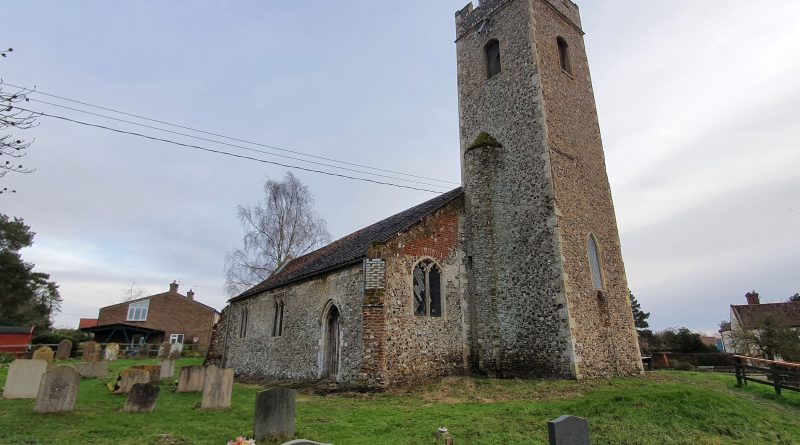Attlebridge – St. Andrew’s Church
I quite like the Attlebridge village sign, it seems to suggest that the church is something similar to St Michael’s Mount, towering above the local countryside.
And here it is, on top of its own hill. But, it’s Norfolk, so I suppose that is quite high. Anyway, Attlebridge was a very different place fifty years ago, the main road to Fakenham thundered by in front of the church and it was a short walk to the nearby railway station. Sadly, that’s gone, with the Marriott’s Way railway line swept away, although the village is likely pleased that a bypass has meant that cars no longer flood through the village.
The church was first built here in what was likely the end of the eleventh century, but the nave was reconstructed in the thirteenth century. The porch is sixteenth century, but perhaps from before the Reformation. George Plunkett has a photo of how the church looked in 1939, taken just a couple of weeks before the outbreak of the Second World War.
The north aisle visible above is fourteenth century. There is a stair turret on the side of the tower, although it only reaches the second stage. Some documentation provided in the church mentions that this was inaccessible by the early twentieth century and it was only reopened in 1984.
The tower is thirteenth or fourteenth century, likely replacing a round tower from the eleventh century. The Victorians spent some money here as the church had become a little derelict by the middle of the nineteenth century, although the Norfolk Chronicle reports in 1903 that funds had been raised to deal with the “tower which has for some time been in a precarious position”.
There’s a niche at the base of the tower that was perhaps previously a window.
The Priest’s Door has been filled in, with some rather big lumps of flint, at some stage in the early nineteenth century.
There some character here, with the old door and the niche on the left hand side.
Located in that niche, this stone figure was found dumped in the river in the 1960s and it was thought that it might be from some form of religious structure, especially as it was nearby to a hermitage side. It is though likely from Attle Bridge, from which the village takes its name, which was reconstructed in 1913. Chances are a workman just thought the stone looked a bit old and dumped it in the river, so a rather less mystical history than might have been hoped for.
The rather old door, I’m unsure of its age, although the arch of the door is likely from the fourteenth century rebuild. I’m still intrigued with the concept of just how many people have crossed the threshold of this door over the centuries, for all manner of weddings, funerals, baptisms and sermons.
Ignoring the restorations of the Victorians, this still feels like a medieval church. Peaceful, slightly damp, and calm, time hasn’t much moved on here. Thanks to Campbell Wodehouse, the vicar here in the late 1850s, there were numerous talks relating to the RNLI, which at that stage was in its relative infancy. The Norfolk News reported in 1860 that the organisation wasn’t that well heard of inland, but Wodehouse had encouraged numerous churches to become involved with their good work.
The chancel. I put my name in the visitor book, the first in a few months.
The north aisle.
The church tower which is blocked off, likely to prevent people meandering up the stairs.
The church’s font, dating to 1866.
I’m not entirely sure why the church has two fonts, this one is located at the entrance to the chancel.
There would have been some rood stair arrangement in the wall here, but that’s a bit complex for me to work out….
An archaeological dig took place in 1989 in the field just to the north of the church, which found evidence of Romano-British settlement. Since the church is on raised ground that would have surely been used, there must have been something located on the site of where the church is now getting on for perhaps not far off two millennia. That’s not a bad heritage to have.


















